Known as the “Windy City of Africa”, don’t let the mighty coastal winds deter you from visiting Essaouira. Formerly known as Mogador, Essaouira’s fortified medina offers visitors a melange of history, traditional culture and character. Various European powers tried in vain to conquer the seaside locality, and their influences are apparent throughout the city.
Walk down to the harbour to watch fishermen bring in the catch from the night prior; walk among the old Marché au Grand where salt used to be traded like gold and catch a glimpse of the kitesurfers from the beachfront. This travel guide to Essaouira, Morocco will tell you what you shouldn’t miss when you visit.
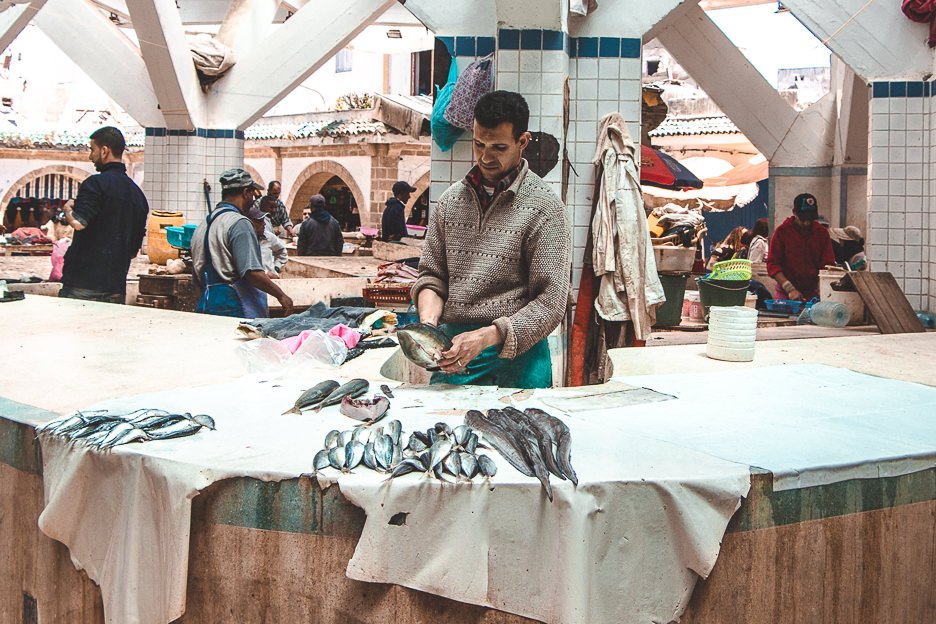
HOW TO SPEND 2 DAYS IN ESSAOUIRA
WHAT TO SEE & DO
Watch the fishermen
When you walk down to Essaouira’s harbour, you’ll be greeted by a sea of blue wooden fishing boats and the overpowering smell of fish. You could call it the lifeblood of the city really. It’s been said that the fishermen paint their boats a traditional blue to not scare the fish. Nobody flaunts their wealth here to avoid the “evil eye”, which these seaside Moroccans believe is death in the middle of the ocean. Fishing boats (“felucca”) are identical in shape and size with Yamaha 25 horsepower motors.
The fishermen take the boats out at night to sell their catch fresh the next morning. When you walk along the harbour or visit the fish market, you’ll glimpse sardines, sea bass, bream, John Dory, Murray eel, mussels, stingrays and maybe even a blue shark. We were informed that the blue shark swims a bit deeper and thus, it takes fishermen out to sea for two days in longline boats. It’s quite a sight to see the locals producing their trade as seagulls hover on the wind and skirt around the edges. If the sight and smell of fresh seafood makes you a bit squeamish, it may be best to stick to the medina.
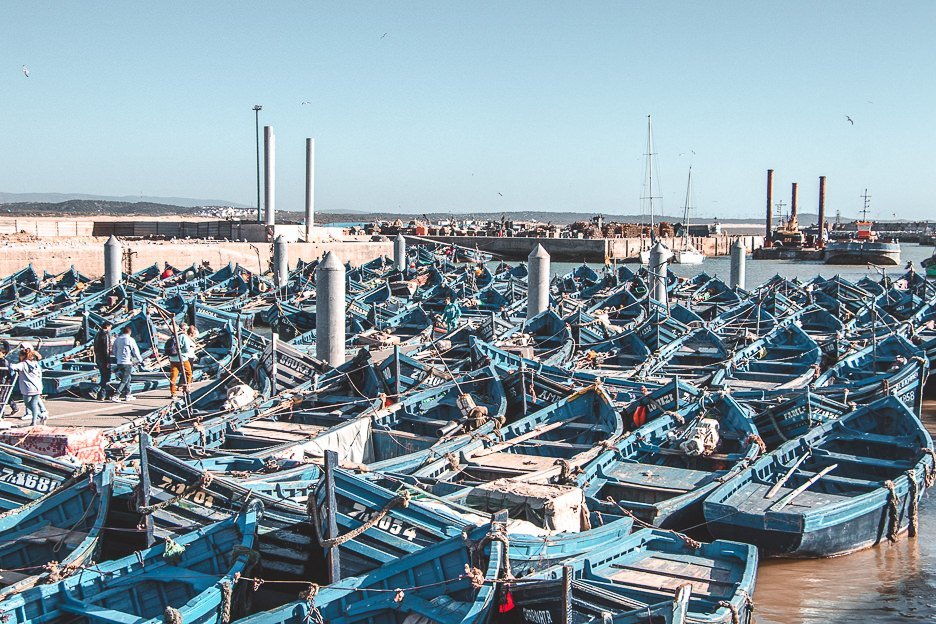
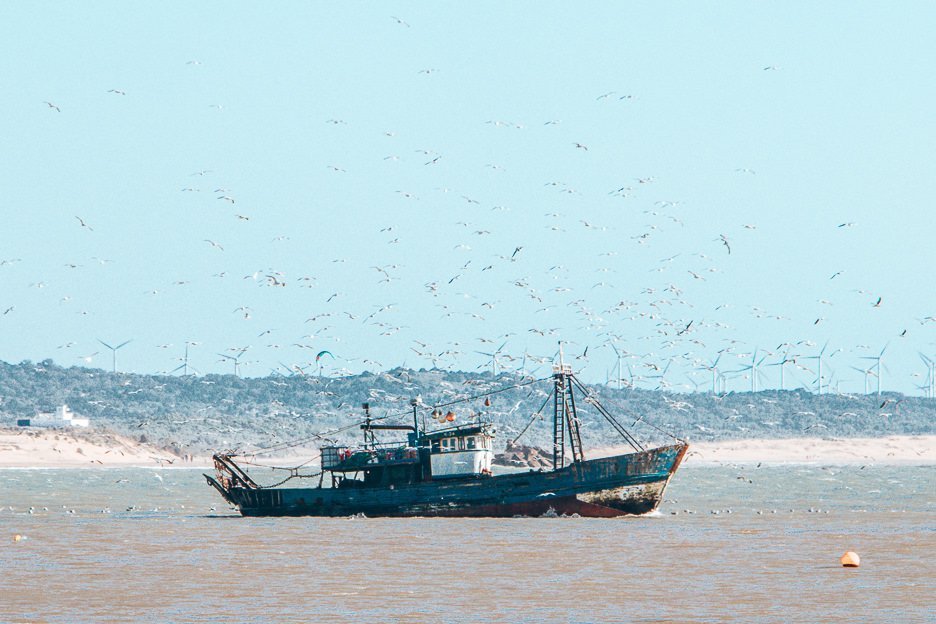
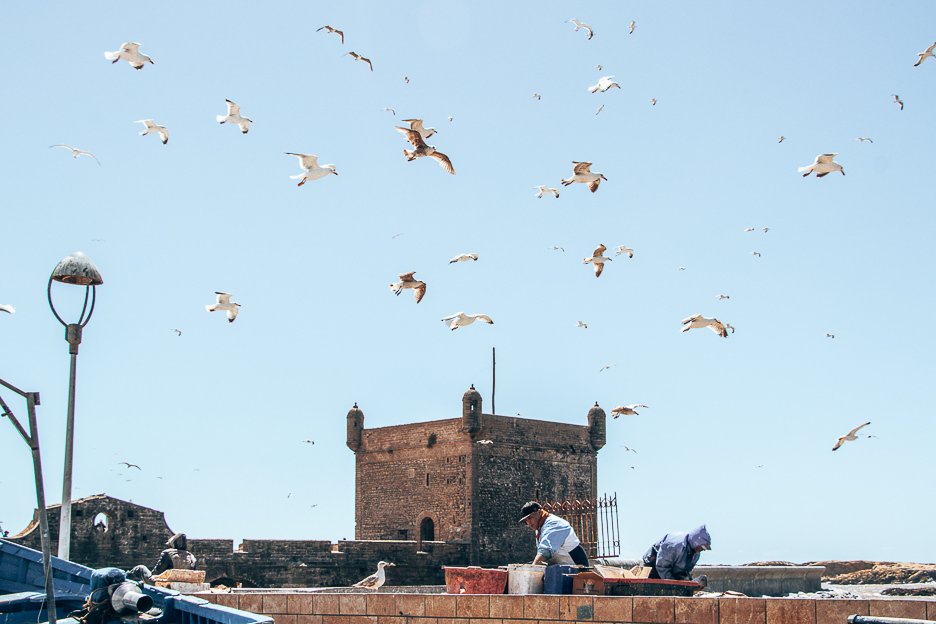
Visit Marché aux Poissons (Fish Market)
Markets play a pivotal role in everyday Moroccan life and it’s the Marché aux Poissons that steals the spotlight in Essaouira. And there’s a role for everybody in this particular show so for a true local experience, ensure you know who plays each role.
Part one involves a visit to the market just off Avenue Mohamed Zerktouni (opposite Marché aux grains) where you will buy your choice of seafood from one of the fishmongers. During our experience, we opted for a few sardines, a handful of large prawns and a sea bass and handed over 60 DH. Next, take your items to the next character who will clean and prepare the fish ahead of cooking. Don’t forget to pay him for his work. Part two – you’ll need some accompaniments for your seafood lunch. Along Avenue Mohamed Serktouni, you’ll find vendors selling olives, bread and fruit and vegetables – pick a selection to go with your fish. Following this act, find a restaurant and hand your seafood over to the chef who will cook it to perfection. The whole process will cost approximately 120 – 150 DH (perhaps a bit extra if you have a guide) and is a unique way to experience Moroccan life!
Skala du Port
Part of the historic fortifications of the city next to the harbour, Skala du Port offers windblown views of Essaouira’s harbour and the walled medina. There’s not a lot upon the bastion and there are no information plaques either. Yet this picturesque corner served has proved a popular filming location, serving as a backdrop in Kingdom of Heaven and Game of Thrones! You’ll find several bronze cannons, a circular hole from which you can take artsy photos of the medina and one tower with four corner guard towers. The winds are mighty up here between the turrets and the seagulls drift lazily on the wind as they circle above the fish stalls below. It’s best to go in the afternoon when the crowds thin but also so that your view of the medina is not covered in shadows.
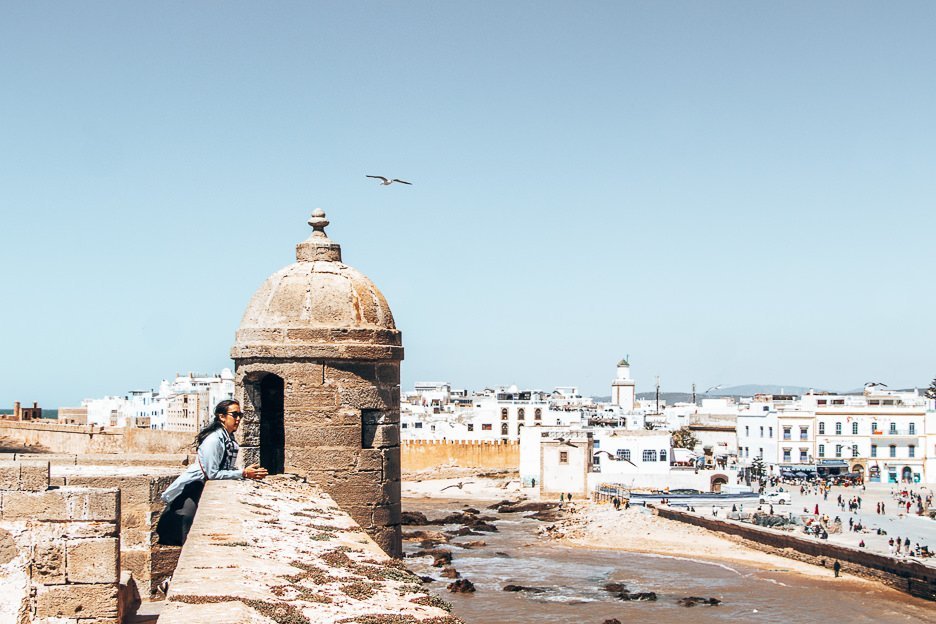
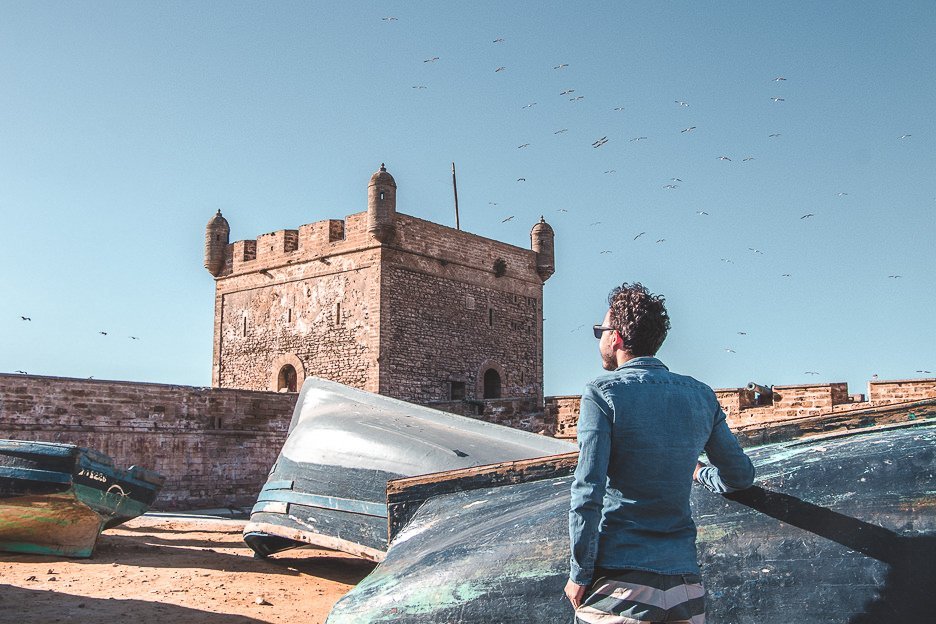
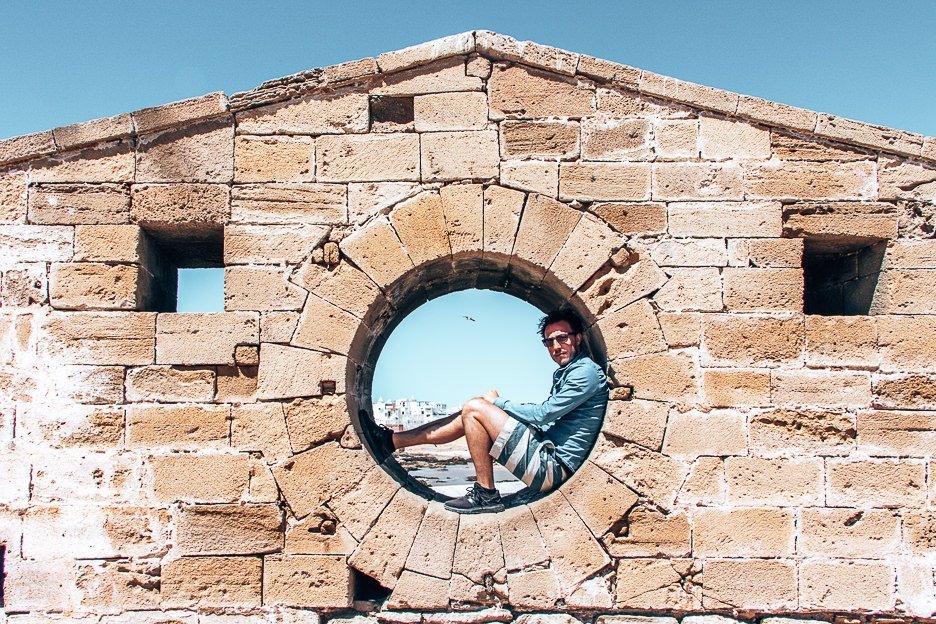
Sidi Mohammed Ben Abdallah Museum
Housed in an old riad, this museum contains artefacts from the region including jewellery, costumes, woodcarving, instruments and weapons. Signage is only available in French and Arabic although the attendant will hand you a single sheet of the museum’s history in English upon paying your entrance fee.
Cost | 10 DH
Opening Hours | Monday – Sunday 8.00am – 6.00pm
Explore the medina
Seek shelter from the strong marine winds within the walls of the medina. Essaouira’s streets are lined with merchants selling leather shoes, ceramic bowls, rugs and wooden products. Prices may be a little less than Marrakech so consider doing your souvenir shopping here.
After shopping, wander over to the old Jewish quarter to admire the old synagogues. The city was once home to 14,000 Jews but following the death of the caravan trade and wars with Arab states, many Jews moved to Israel. There are now only approximately 4,000 Jews left in Morocco of a population of 35 million with 3 families remaining in Essaouira.
Make your way over to Bab Skala where you’ll find 4-tonne bronze cannons lining this section of the City Walls. The cannons have varying origins coming from Algeria, Spain and the Netherlands, with various powers fighting to conquer the city throughout the 16th century. Look out for the intrinsic detail on the Dutch cannons featuring a dragon head on one side representing death and fire while the dolphin on the other side is said to symbolise life, peace and prosperity.
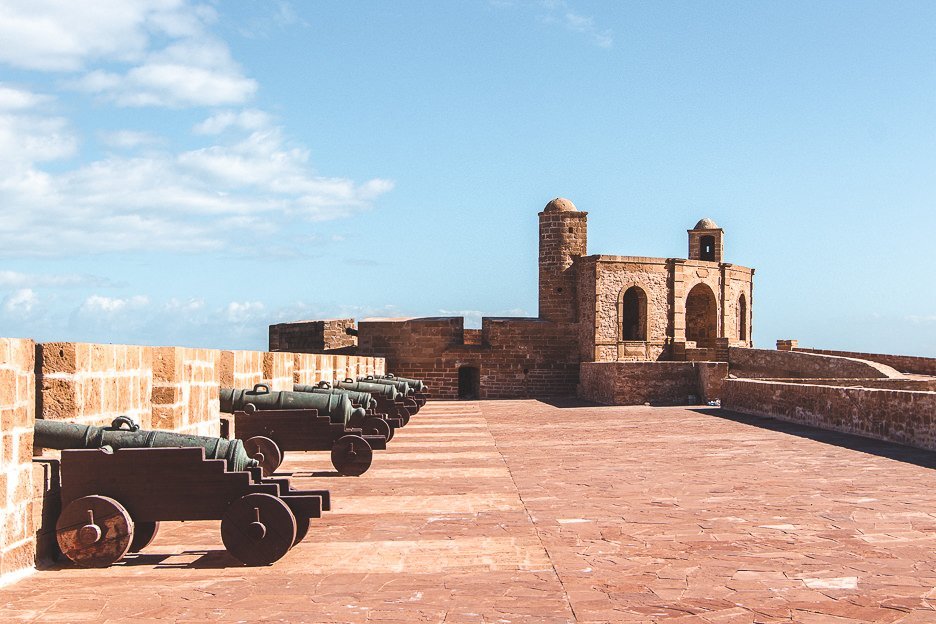
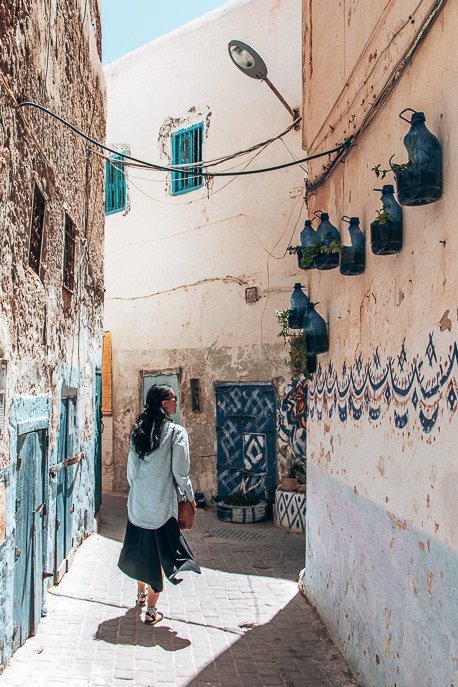
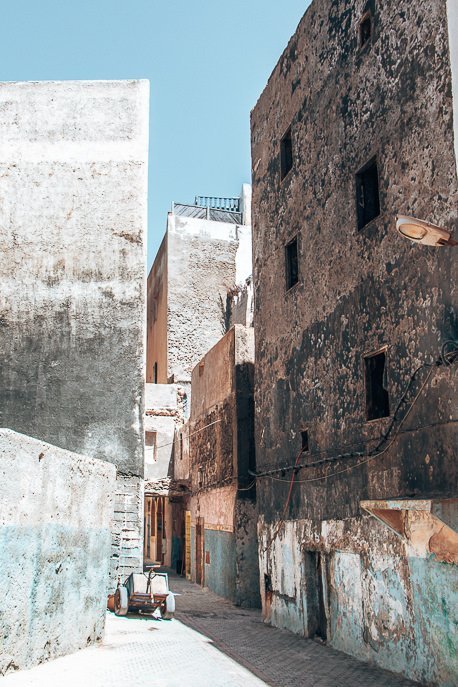
WHERE TO EAT & DRINK
Having travelled through the desert the week prior, we were looking forward to discovering where to eat in Essaouira and going beyond the tagine.
The Loft
After 8 days in a row of eating tagine or couscous for lunch and dinner, our palettes were looking for some other food options. The Loft more than satisfied our cravings! With some fellow tour group members, we scoffed down starters of spring rolls stuffed with goats cheese, dry raisins and walnuts; shared crab tartare with smashed avocado and devoured a mille feuille featuring more goats cheese. Being by the seaside, seafood was the specialty on the menu and we couldn’t resist. Our mains were grilled John Dory and monkfish in white sauce with side accompaniments including lentils, mashed potato and some more smashed avocado. Nobody said no to dessert and so our spoons dived into saffron crème brûlée, homemade yoghurt with nuts and honey and chocolate mousse. Deliciousness.
The Loft is a two-level restaurant with eclectic, retro decor. Oval glass table tops with colourful lamp shades and mismatched cushions, various shaped mirrors on the wall and shelves housing rainbow patterned vases and vintage radio. Like most establishments in the city and the country, no alcohol is available so settle in with fresh fruit juices and make sure to take some grand company with you.
Reservations recommended.
Opening Hours | Monday – Sunday 10.00am – 11.00pm
Website | The Loft on Facebook
Mega Loft
It may first seem like a tourist trap but once inside, we don’t think you’ll mind. For a contemporary twist, Mega Loft features traditional berber baskets on the walls and ceiling. Tabletops are newspaper-cartoon strips from the 60s and a live band strikes up in the evenings to entertain diners. This restaurant cross art gallery is resplendent with colour inside and out, alongside a menu that takes advantage of the fresh seafood that arrives in the harbour each day. We feasted on fat, juicy prawns and a seafood gratin and washed it down with some refreshing homemade lemonade. Delicious!
Pâtisserie Driss
According to those in the know, Pâtisserie Driss is the best bakery in town and the place all the locals go. Opened in 1928, the cafe is located next to BMCE Bank. The array of sweets in the front window will tempt you inside. You’re welcomed by another cabinet full of cakes, pastries and sweets which all cost 6 DH or less. If you choose to eat in, order a nous nous from the next counter and then head out to the semi-hidden courtyard. Sit among the loyal regulars and admire the colourful paintings of Moroccan life which adorn the courtyard walls.
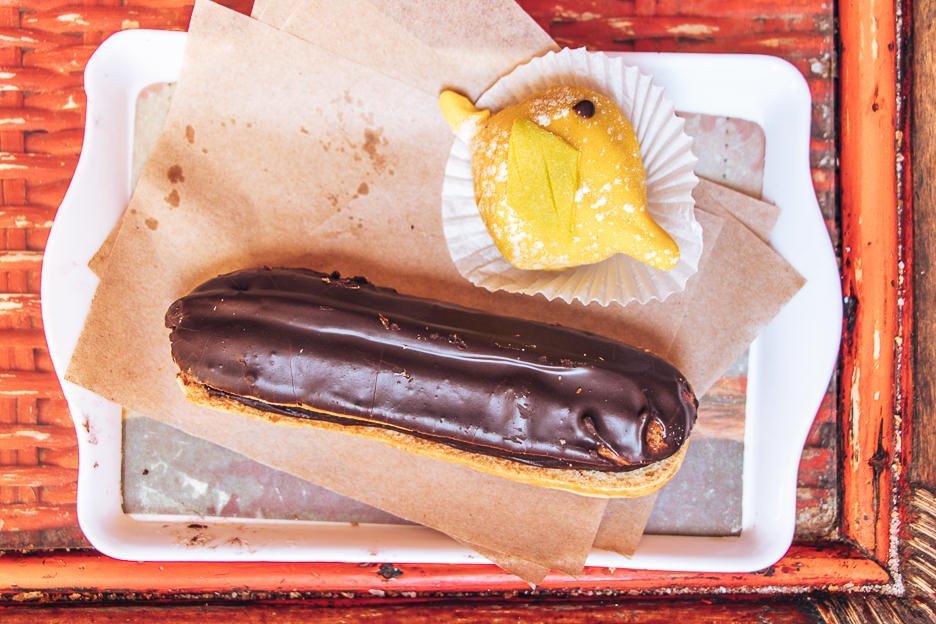
Yoo Essaouira Healthy Food
If you’re craving a refreshing treat without too many naughty calories, you must visit Yoo. The healthy food shop serves up slow pressed juices, frozen “yoogurt” and smoothies. It’s the perfect pit-stop if you need to cool down from the blistering heat or for those wanting some other fruit and vegetables to go with their orange juice.
Address | 8 Rue Ibn Roch, Essaouira 44000, Morocco
Opening Hours | Monday – Saturday 10.00am – 6.00pm. Sunday – Closed.
Website | https://www.yoomaroc.com/
Taros
For an eagle’s nest view over the main square of Essaouira, head to the rooftop of Taros. The multi-level venue caters to the tourist crowd who come searching for an alcoholic beverage after a day of sightseeing. Watch the sunset over the medina or swing by after dinner to enjoy some live music with a nightcap.
Opening Hours | Monday – Sunday 10.00am – 12.00am
Website | Taros on Facebook
WHERE TO SHOP
Centre de la Bijouterie Artisanale
The Jewish community produced many skilled silversmiths who were famed for their quality jewellery output. Since most of the Jews departed the city, there are only a few skilled tradesmen remaining. The Centre de la Bijouterie Artisanale supports young Moroccans with disabilities, teaching them the silversmith trade so that they can produce an income for themselves. You’re permitted to wander through the workshop to see the artisans at work before entering a small Aladdin’s cave filled with necklaces, pendants, bracelets, earrings and rings. Each item is marked with an artisan’s number so should you wish to make a purchase, you know that your dirhams are supporting local Moroccans.
Opening Hours | Monday – Sunday 9.00am – 9.00pm
Website | https://centre-de-la-bijouterie-artisanale-maalem-ali.business.site/
Centre Artisanal D’Essaouira
Many artisans in Essaouira are skilled cabinet makers and wood carvers, these skills having been practiced for centuries. In the present day, approximately 65% of the men in Essaouira will have trained as a woodcarver apprentice during their childhood.
One of the primary materials is the root and stem of thuya trees, a non-endangered species that grows between Essaouira and Agadir. For every thuya tree cut down, ten are planted in its place with approximately 380 hectares planted each year. Woodworkers will also use lemon wood from lemon trees, a white-yellow coloured wood that is carved into intricate patterns and laid into darker coloured woods from thuya trees and acacia trees. Other decorative elements include copper and aluminium.
The Centre Artisanal D’Essaouira is a workshop and a store selling wooden furniture and homewares. Think dining tables and chairs, jewellery boxes, coasters, animal statues, chess sets and salt and pepper shakers. All wood is treated and comes with official certification; a fact that the workshop is keen to reiterate for its Australian customers!
Opening Hours | Monday – Sunday 8.00am – 9.30pm
Website | Centre Artisanal D’Essaouira on Facebook
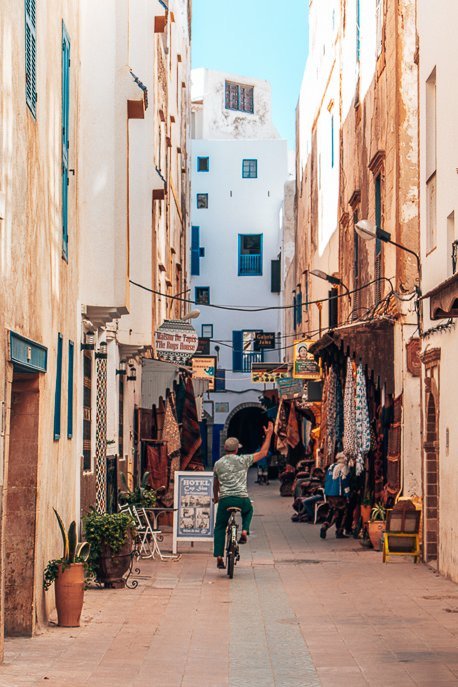
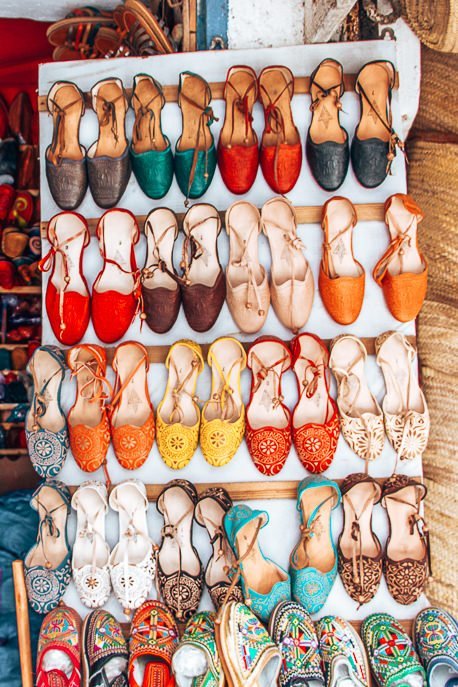
Souks in the medina
The souks are a treasure trove. From leather shoes and bags, homewares, art and jewellery, there will be plenty that you’ll want to take home.
TIP: Be cautious when buying goods in the souks, particularly jewellery. We were informed by our tour guide that some Berbers try to flounce goods on the streets for a “good price”, claiming to be authentic antique silver.
WHERE TO STAY
Riad Chakir
We stayed at Riad Chakir as part of our Intrepid South Morocco Discovery Tour. A simple hotel, rooms are small but neat and clean and come with everything you need for a short stay. The internal staircases lead up to a rooftop terrace where guests are welcome to bask in the sun. Riad Chakir is in a superb location, a short walk from the main gates and harbour. Breakfast was also included.
5 Columns
For modern luxury within the ancient medina, 5 Columns ticks all our interior design goals plus more. Housed in a beautifully restored 18th-century house, this self-catering accommodation has retained many of its original features including sandstone columns and thuya wood ceilings. The four-level house sleeps up to 8 guests and boasts two large sunny terraces, an outside kitchen plus two lounge salon rooms.
WHAT TO KNOW BEFORE YOU GO
Porters
Before the gates of Bob Sbaa, you’ll find porters waiting at the taxi rank and bus drop off area. They are willing to assist you with both directions and your luggage. We paid 20 DH per person when travelling with a large group. Whilst the medina is not as complex as Marrakech, using a porter means you’re likely to find your accommodation more quickly and you’re helping to support the local economy.
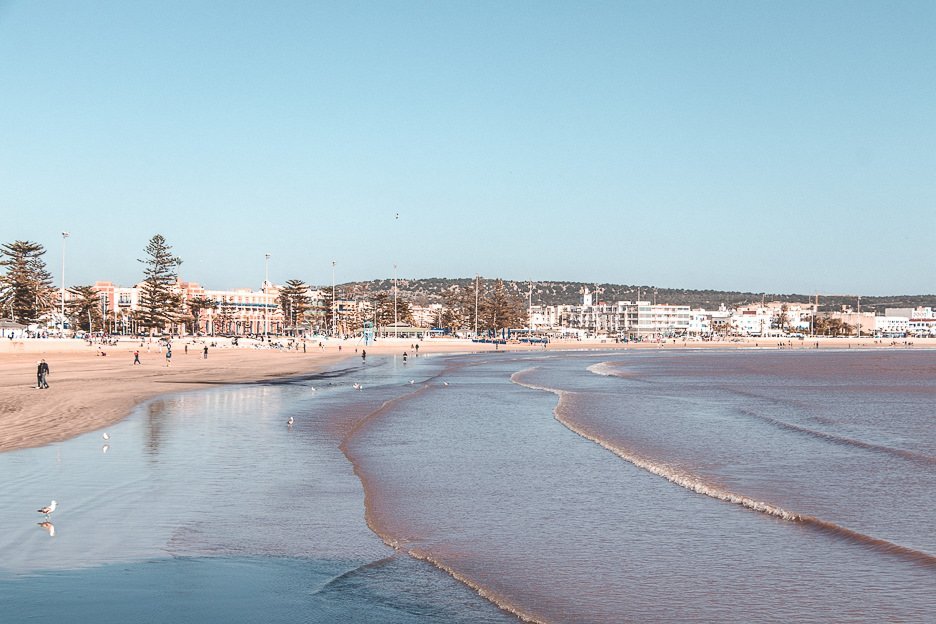
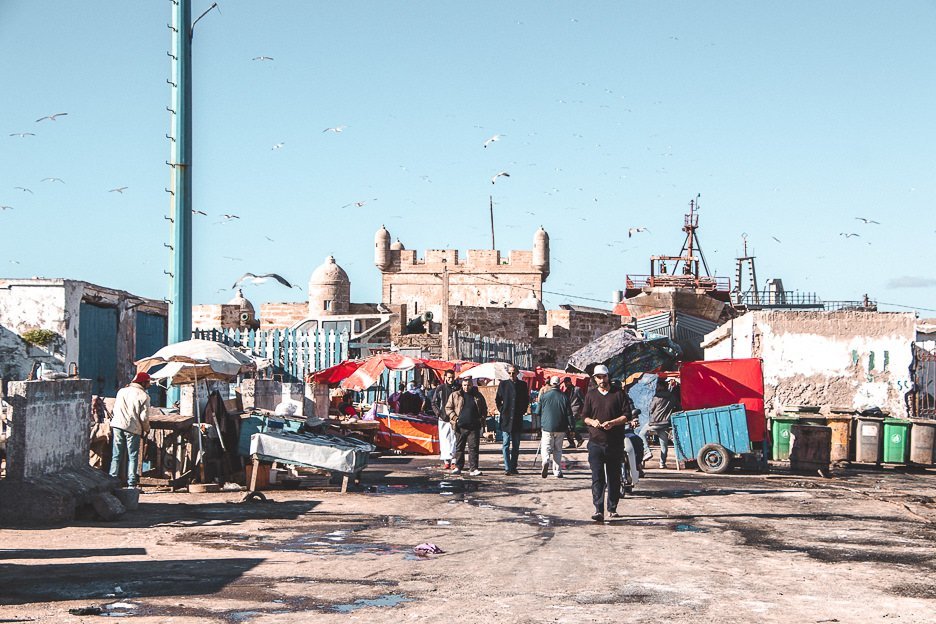
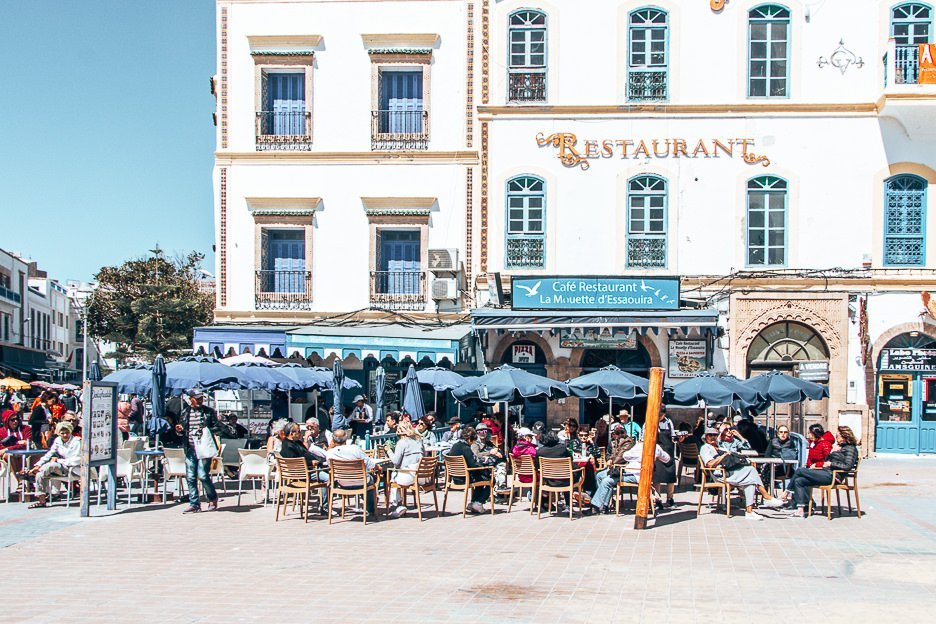
Parking
If you’re planning on hiring a car and driving to Essaouira, then be prepared to leave your car on the outskirts of the city. No cars are allowed in the medina. The main parking areas are at the end of the beach before you reach the port and next to Hospital Sidi Mohammed Ben Abdullah.
Fish Markets
If choosing to buy your seafood fresh for preparation at a restaurant, take care in your selection of vendor. Our tour guide to Essaouira warned us that the vendors in Moulay Hassan Square are known for fleecing tourists, either by upping the weight of the fish or swapping your selection for lower quality fish. For less fuss, we recommend paying a visit to Marché aux Poissons.
HOW TO GET THERE
- By Bus
There are two reliable bus companies in Morocco: Supratours and CTM. The journey from Essaouira to Marrakech is approximately 3 hours. A second class ticket will cost around 80 DH. The latest schedules and prices can be found online and we recommend booking your ticket in advance as seats are allocated. These buses are coach style with comfortable seats and air-conditioning.
LIKE THIS POST? PIN IT AND SHARE IT!
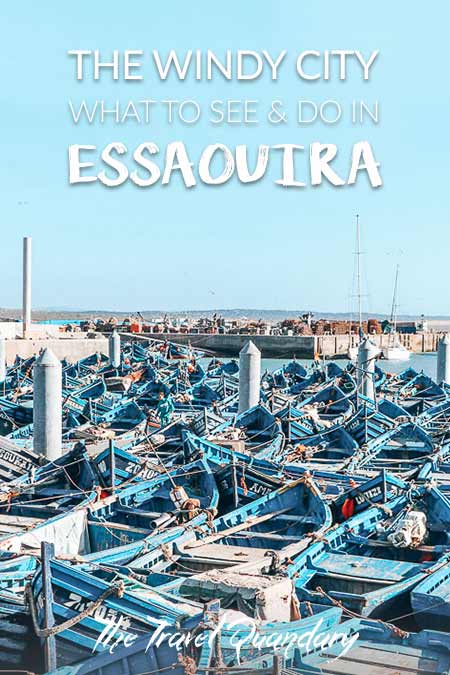
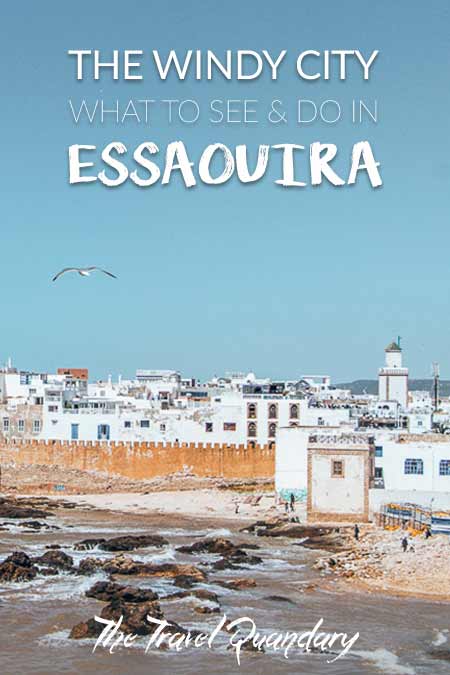

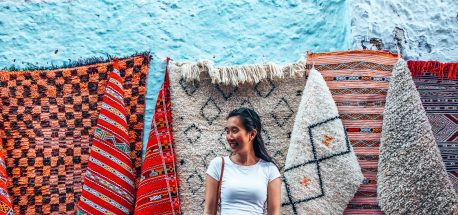
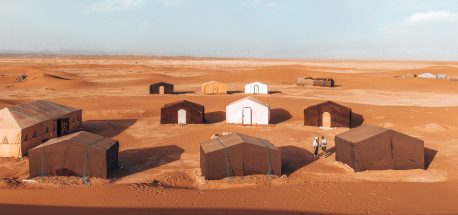

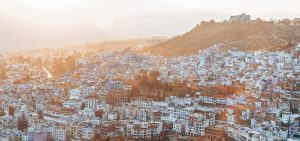
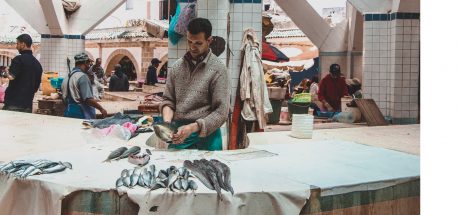

I really liked reading your article.
you are doing a great job.
Morocco desert tour